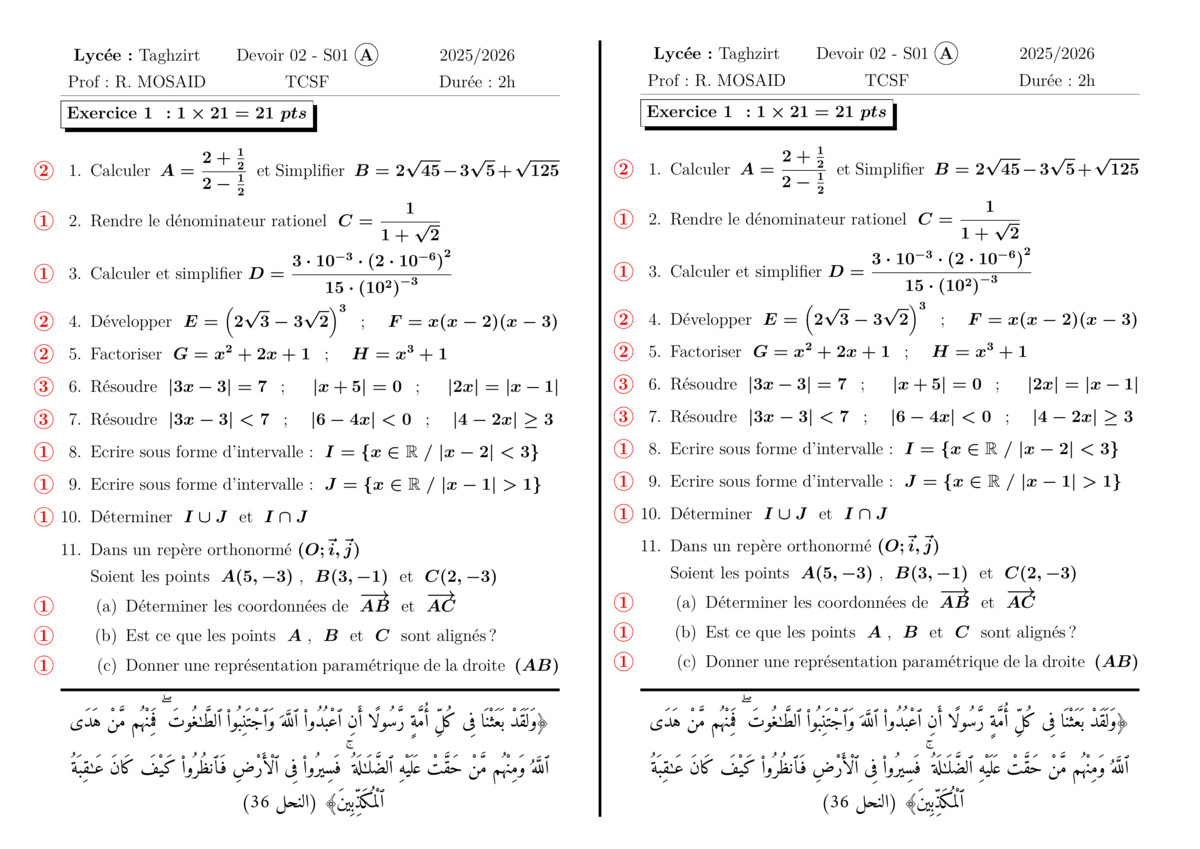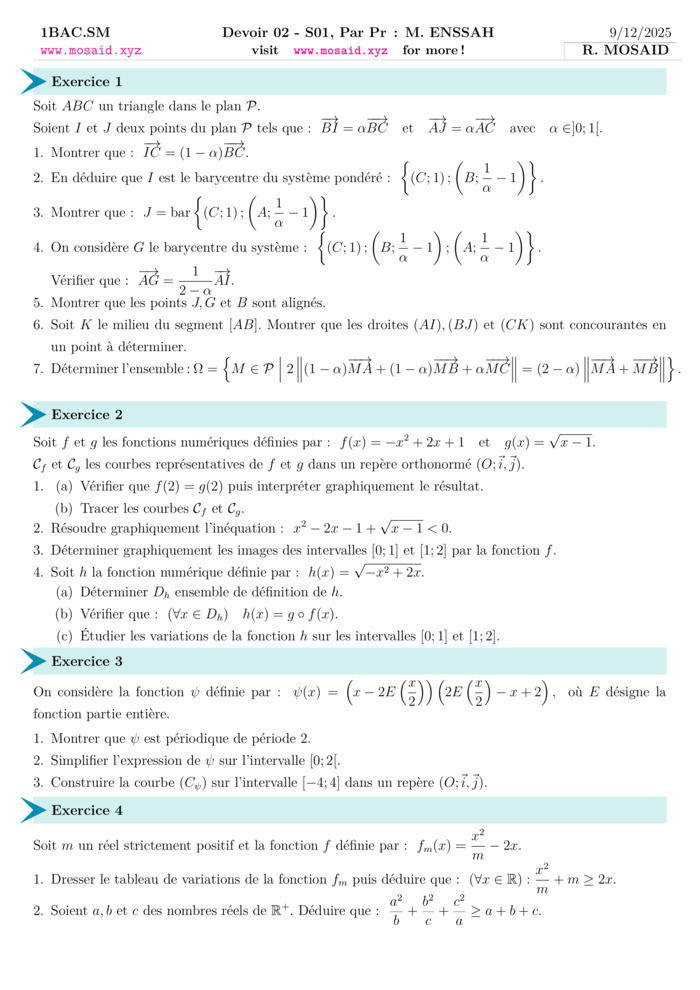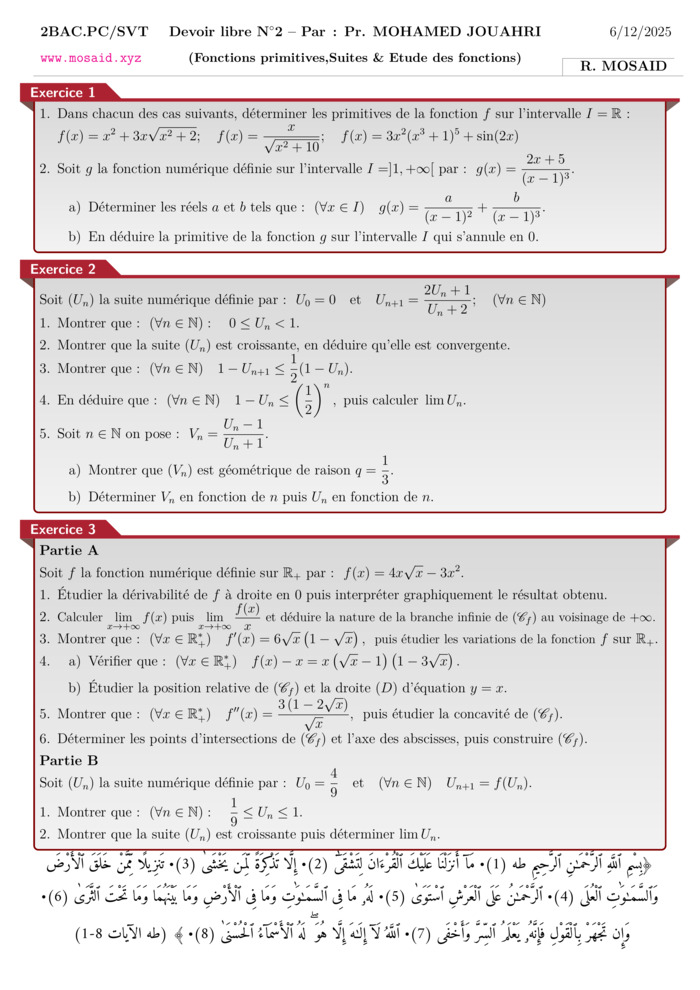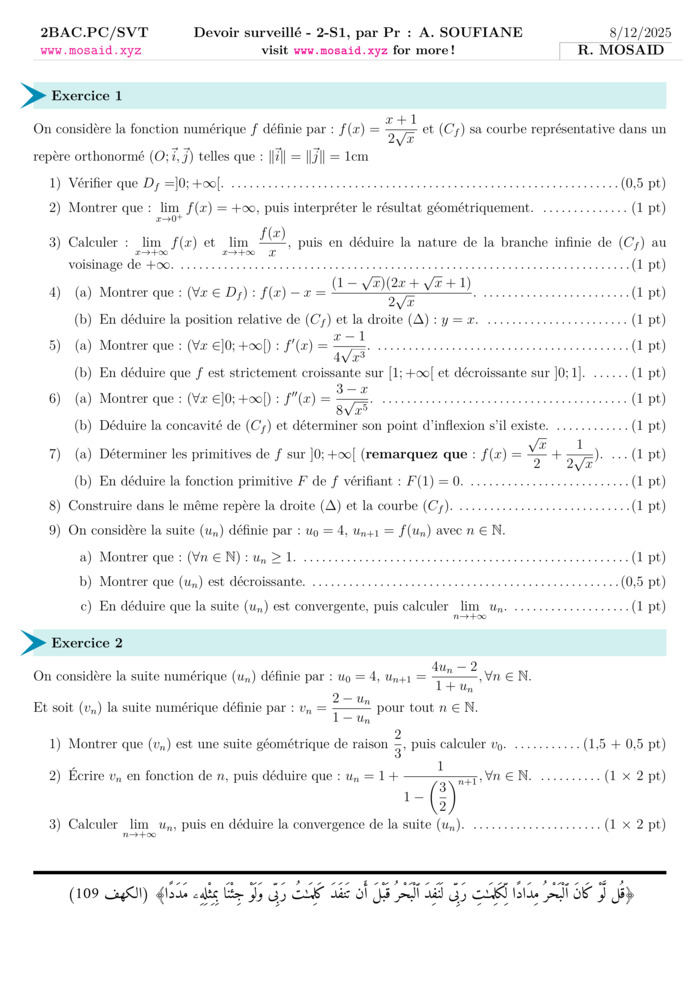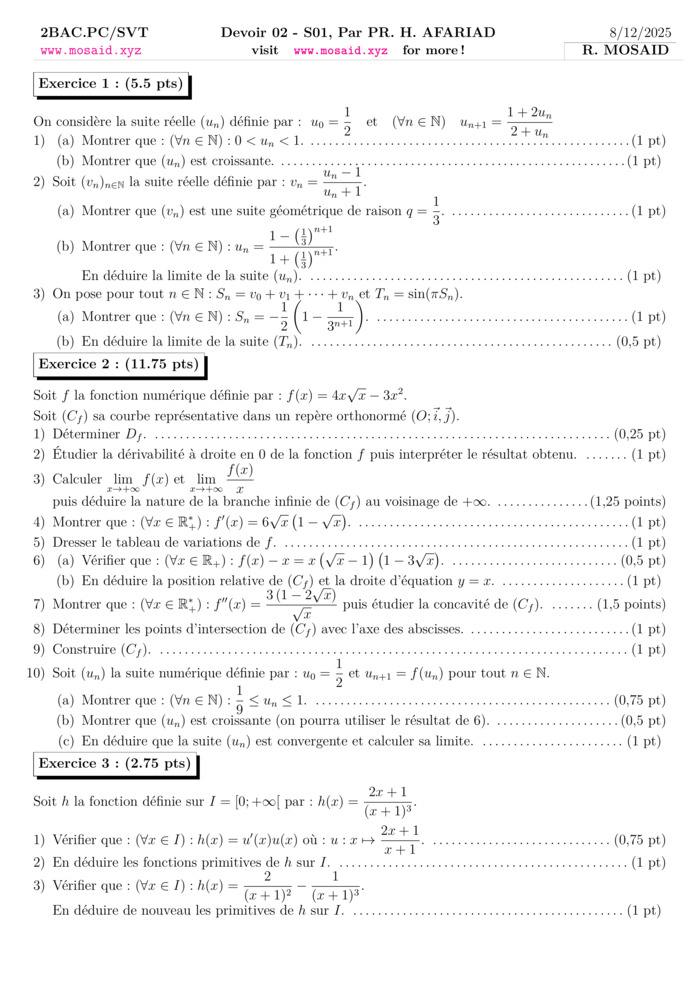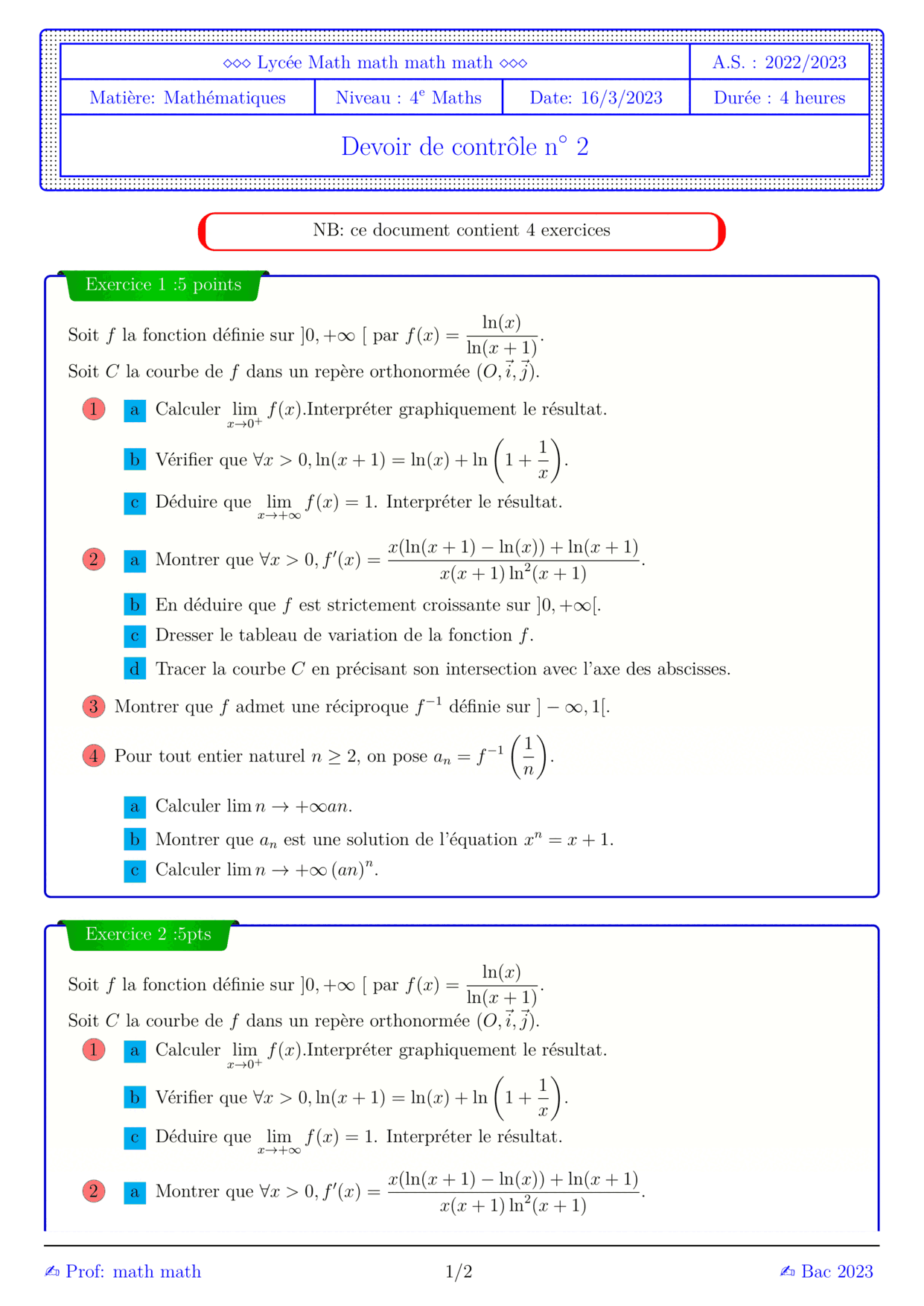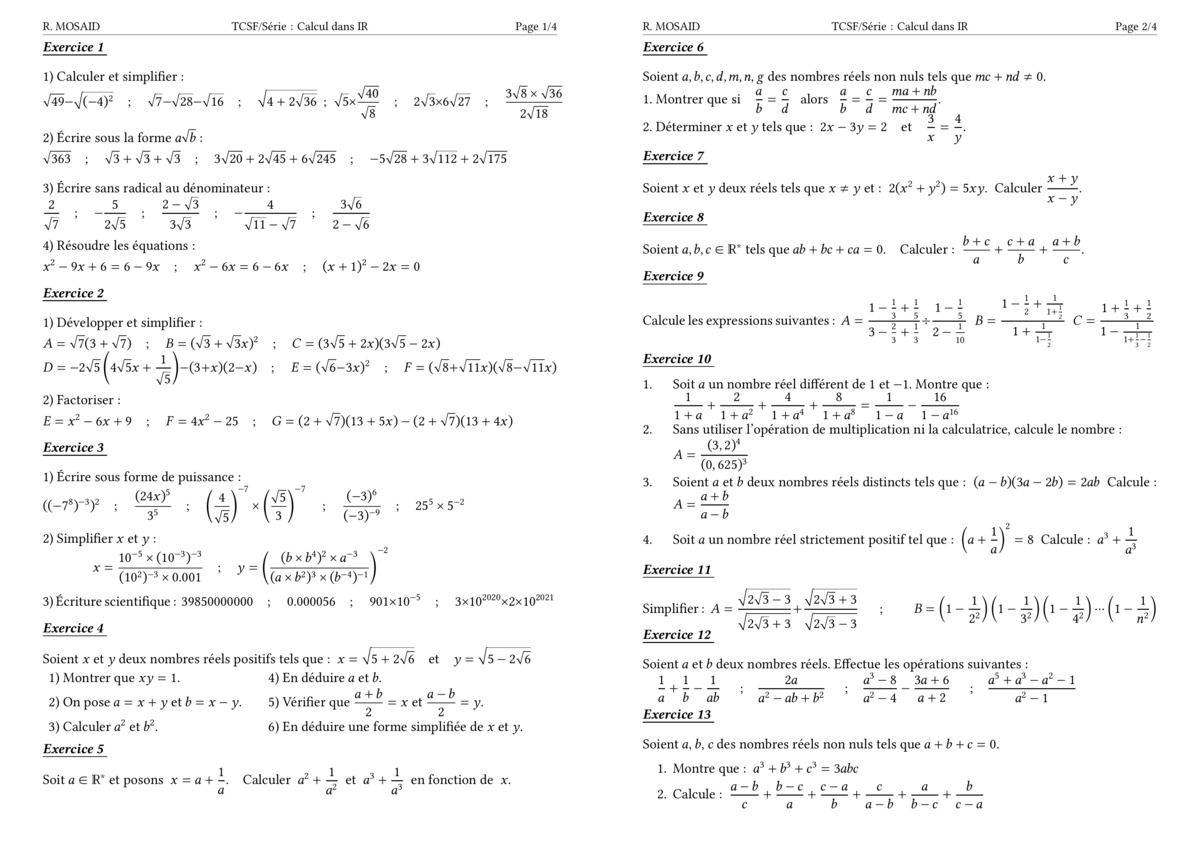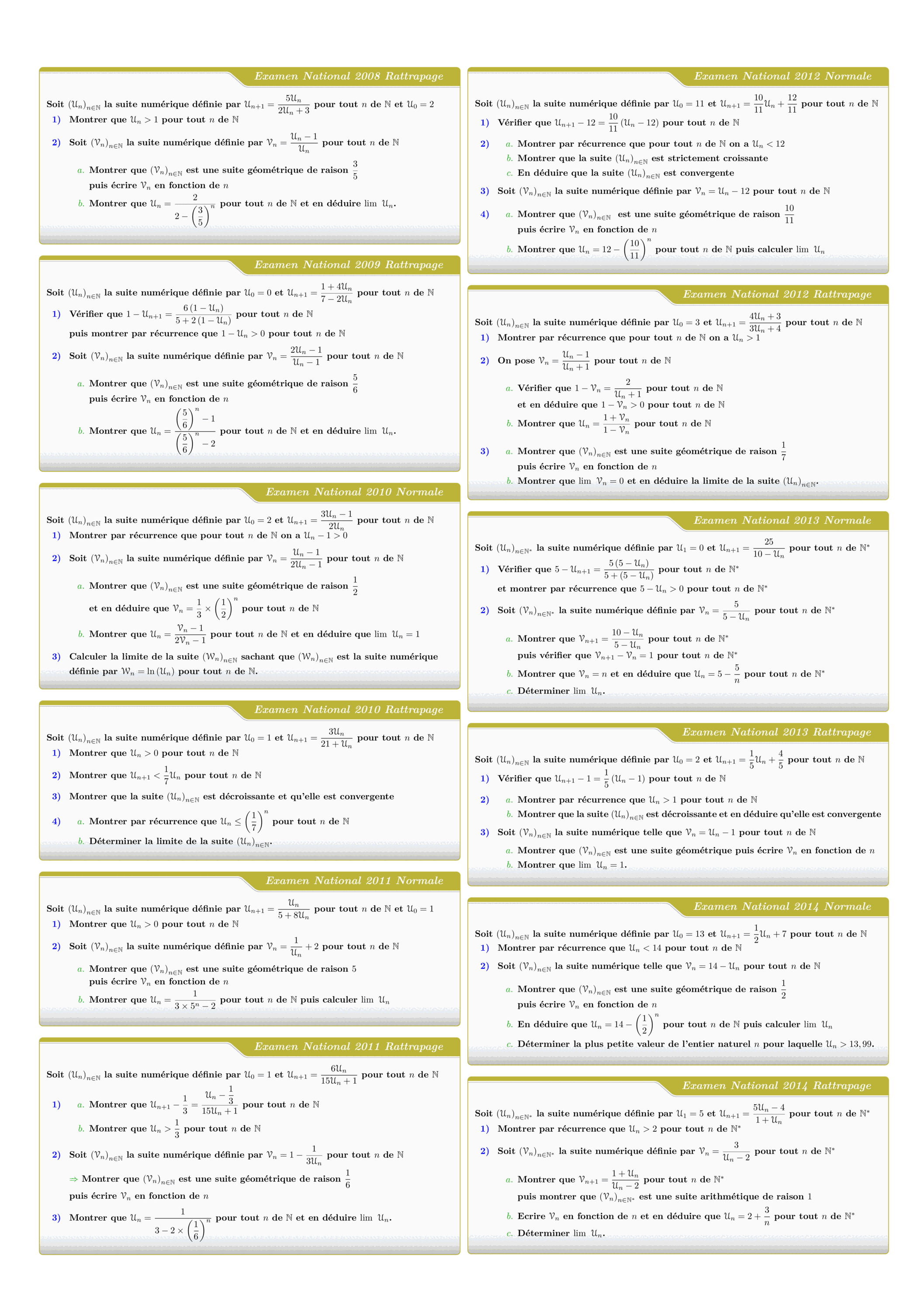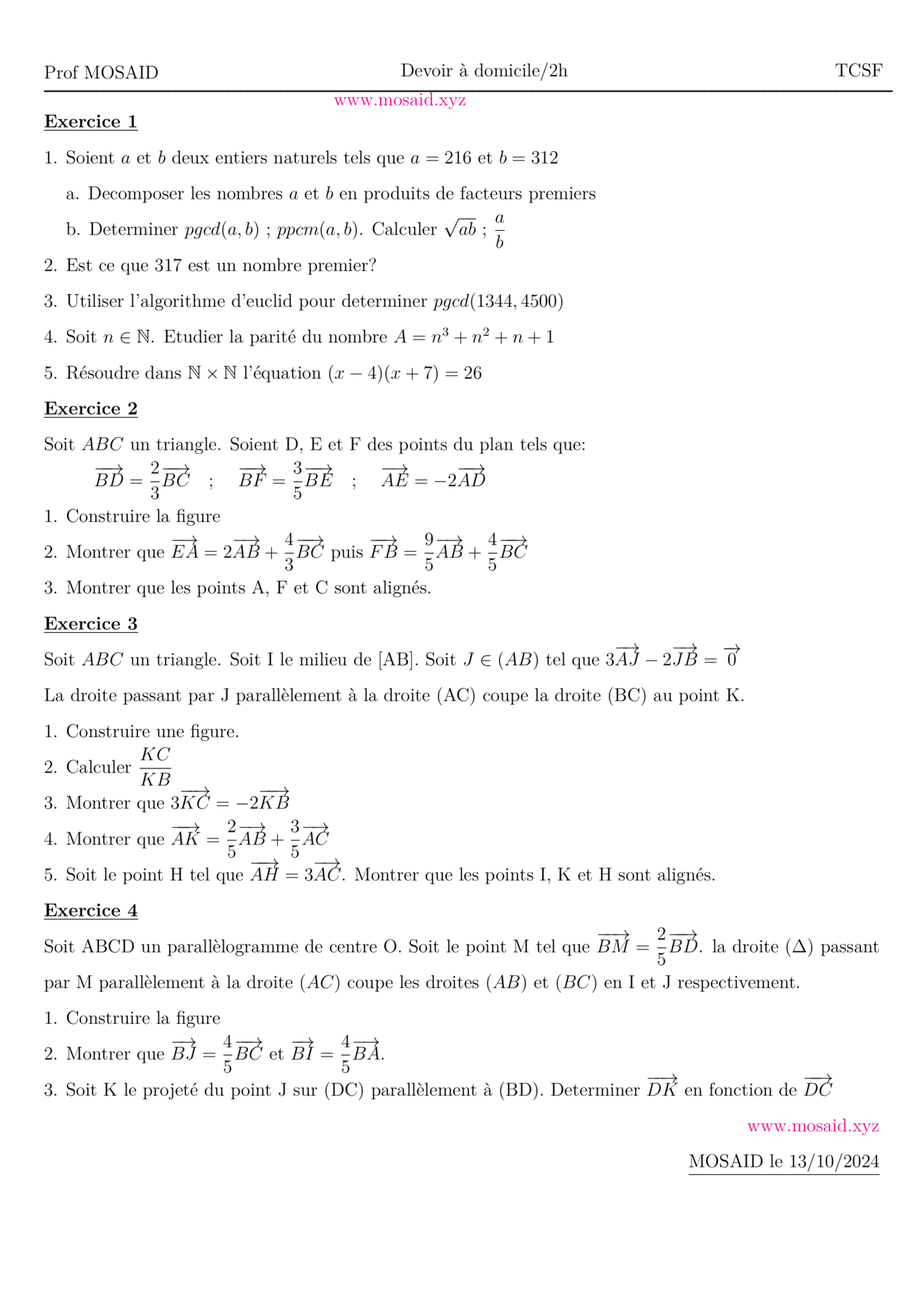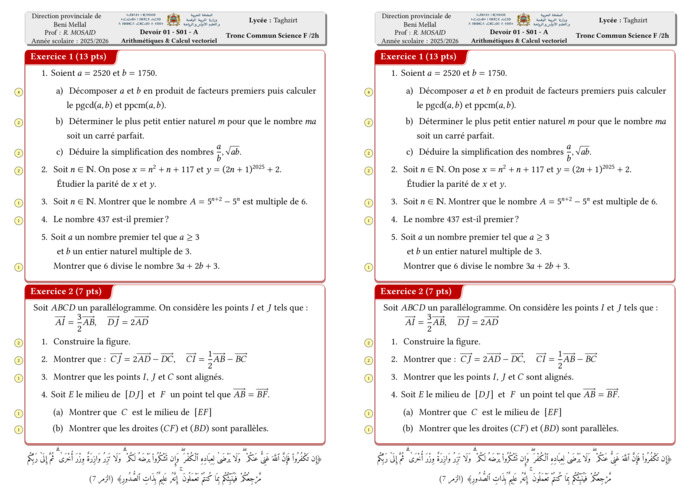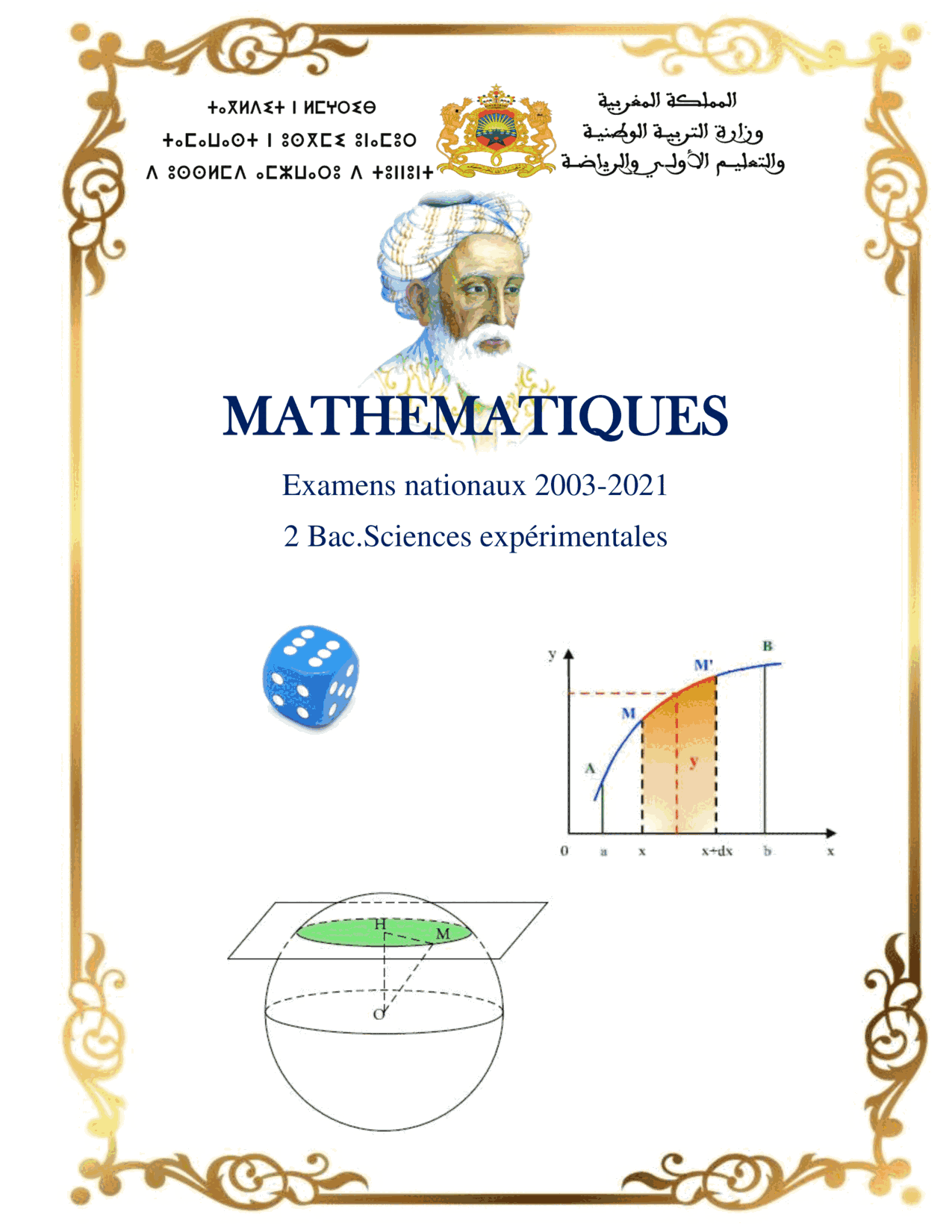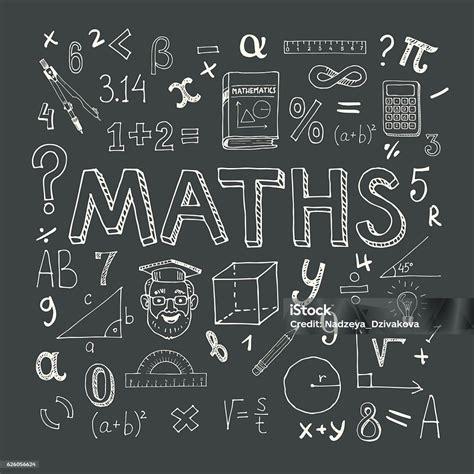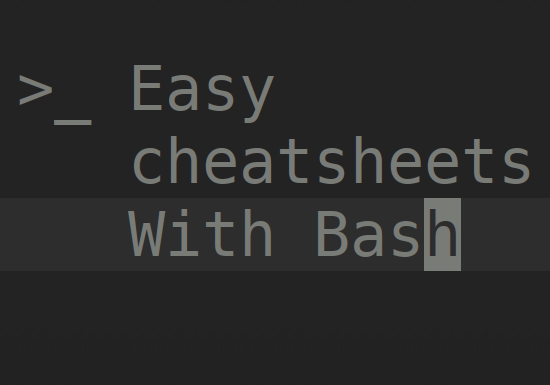Correction Série de logique
📅 October 20, 2025 | 👁️ Views: 299

\documentclass[12pt]{article}
\usepackage[left=1cm,right=1cm,top=1.5cm,bottom=1.5cm]{geometry}
\usepackage{amsmath, amsfonts, amssymb, amsthm}
\usepackage{setspace}
\usepackage{fancyhdr}
\usepackage{xcolor}
\usepackage{titlesec}
\titlespacing*{\subsection}{0pt}{0.3cm}{0.2cm}
\usepackage{multicol}
\setlength{\columnseprule}{0.4pt} % thickness of the vertical line
\setlength{\columnsep}{0.5cm} % horizontal space between columns
\usepackage{xparse}
\NewDocumentCommand{\no}{m}{\overline{\#1}}
\newcommand{\myrule}{\vspace*{0.3cm}\hrule height 1.5pt\vspace*{0.3cm}}
\newcommand{\bm}[1]{\ensuremath{\boldsymbol{\#1}}}
\setstretch{1.5}
\everymath{\displaystyle}
\setlength{\parindent}{0pt}
\begin{document}
\begin{center}
{\Huge Correction Série de logique de: Prof Migroune}\\[0.5cm]
{\large Par : Prof \textbf{MOSAID}}
\end{center}
\begin{multicols*}{2}
\section{\underline{Exercice 1}}
1. On considère la proposition \\\( P : (\forall x \in \mathbb{R}) : (x^2 = 25 \Rightarrow x = 5) \).
\subsection*{Négation de \( P \)}
Rappel : \( \overline {P \Rightarrow Q }\Leftrightarrow P \text{~et~} \no Q \). \\
Donc \( \no P : (\exists x \in \mathbb{R}) : x^2 = 25 \text{ et } x \neq 5 \). \\
\( \no P \) est vraie pour \( x = -5 \), car \( (-5)^2 = 25 \text{~et~} -5 \neq 5 \) est vraie \\
Ainsi, \( P \) est fausse.
\myrule
2. Montrer que \( (\forall x \in \mathbb{R}) : \frac{4x}{x^2 + 4} \leq 1 \). \\
On a : \( x^2 + 4 - 4x = (x - 2)^2 \geq 0 \), \( \forall x \in \mathbb{R} \). \\
Donc \( x^2 + 4 \geq 4x \). \\
Ainsi, \( 1 \geq \frac{4x}{x^2 + 4} \), car \( \forall x \in \mathbb{R}, x^2 + 4 \neq 0 \).
\myrule
3.a Montrer que \( (\forall x \in \mathbb{R}) : x^2 - x + 1 \geq 0 \). \\
Il suffit de calculer le discriminant \( \Delta \) et d'étudier son signe.
On a : \( \forall x \in \mathbb{R},\ x^2 - x + 1 > 0 \). \\
En effet, le discriminant de \( x^2 - x + 1 \) est\\ \( \Delta = (-1)^2 - 4 \times 1 \times 1 = 1 - 4 = -3 < 0 \),
donc le polynôme est toujours du signe de \( a = 1 > 0 \),\\ d'où \( x^2 - x + 1 > 0 \) pour tout \( x \in \mathbb{R} \).
b. Montrer que \( \forall x, y \in \mathbb{R} \) :\\
~$ (x + y \neq 1) \Rightarrow \left( \sqrt{x^2 - x + 1} \neq \sqrt{y^2 - y + 1} \right) $~
On procède par démonstration par contraposée. \\
On veut montrer que :\\
~$ \sqrt{x^2 - x + 1} = \sqrt{y^2 - y + 1} \Rightarrow (x = y \text{ ou } x + y = 1) $~
On a :
~$\sqrt{x^2 - x + 1} = \sqrt{y^2 - y + 1} \Rightarrow x^2 - x + 1 = y^2 - y + 1 $~
\begin{align*}
&\Rightarrow x^2 - y^2 - (x - y) = 0 \\
&\Rightarrow (x - y)(x + y) - (x - y) = 0 \\
&\Rightarrow (x - y)(x + y - 1) = 0 \\
&\Rightarrow x - y = 0 \text{ ou } x + y - 1 = 0 \\
&\Rightarrow x = y \text{ ou } x + y = 1
\end{align*}
Ainsi, par contraposée, on a bien :\\
~$ \forall x, y \in \mathbb{R},\ (x + y \neq 1) \Rightarrow \left( \sqrt{x^2 - x + 1} \neq \sqrt{y^2 - y + 1} \right) $~
\myrule
4. Résoudre dans ~$\mathbb R$~ : ~$|2x+6|-4=0$~
On procède par disjonction de cas.
\subsection*{Cas 1 : \( 2x + 6 \geq 0 \) c'est-à-dire \( x \geq -3 \)}
On a :
\begin{align*}
2x + 6 - 4 &= 0 \\
2x + 2 &= 0 \\
x &= -1
\end{align*}
Cette solution est acceptée car \( -1 \geq -3 \).
\subsection*{Cas 2 : \( 2x + 6 \leq 0 \) c'est-à-dire \( x \leq -3 \)}
On a :
\begin{align*}
-(2x + 6) - 4 &= 0 \\
-2x - 6 - 4 &= 0 \\
-2x - 10 &= 0 \\
-2x &= 10 \\
x &= \frac{-10}{2} = -5
\end{align*}
Cette solution est acceptée car \( -5 \leq -3 \).
\subsection*{Conclusion}
L'ensemble des solutions est \( S = \{-1, -5\} \).
\myrule
5. Montrer par récurrence que pour tout \( n \in \mathbb{N} \) :\\
~$ 5^0 + 5^1 + 5^2 + \cdots + 5^n = \frac{5^{n+1} - 1}{4} $~
\subsection*{Initialisation : pour \( n = 0 \)}
\begin{itemize}
\item On a : \( 5^0 = 1 \)
\item Et : \( \frac{5^{0+1} - 1}{4} = \frac{5 - 1}{4} = \frac{4}{4} = 1 \)
\item Donc \( P(0) \) est vraie.
\end{itemize}
\subsection*{Hérédité}
On suppose que \( P(n) \) est vraie, c'est-à-dire :\\
~$ 5^0 + 5^1 + \cdots + 5^n = \frac{5^{n+1} - 1}{4} $~
On veut montrer que \( P(n+1) \) est vraie :\\
~$ 5^0 + 5^1 + \cdots + 5^{n+1} = \frac{5^{n+2} - 1}{4} $~
\subsection*{Démonstration :}
\begin{align*}
5^0 + 5^1 + \cdots + 5^{n+1} &= (5^0 + 5^1 + \cdots + 5^n) + 5^{n+1} \\
&= \frac{5^{n+1} - 1}{4} + 5^{n+1} \\
&= \frac{5^{n+1} - 1 + 4 \times 5^{n+1}}{4} \\
&= \frac{5 \times 5^{n+1} - 1}{4} \\
&= \frac{5^{n+2} - 1}{4}
\end{align*}
\subsection*{Conclusion}
La propriété est vraie pour tout \( n \in \mathbb{N} \).
\myrule
6. Montrer par récurrence que ~$\forall n \in \mathbb N$~:\\
~$ 1 + 3 + 5 + \cdots + (2n-1) = (n+1)^2 $~
\subsection*{Initialisation : pour $n = 0$}
On a ~$2 \times 0 +1= 1$~\\
et ~$(0+1)^2=1$~
Donc la propriété est vraie pour $n = 0$
\subsection*{Hérédité}
Supposons la propriété vraie au rang $n$, c'est-à-dire :\\
~$ 1 + 3 + 5 + \cdots + (2n+1) = (n+1)^2 $~
Montrons qu'elle est vraie au rang $n+1$ :\\
~$ 1 + 3 + 5 + \cdots + (2n+1) + \left(2(n+1)+1\right) = (n+2)^2 $~
\subsection*{Démonstration :}
\begin{align*}
&1 + 3 + 5 + \cdots + (2n+1) + \left(2(n+1)+1\right) \\
&= (n+1)^2 + 2(n+1)+1 \\
&= [(n+1)+1]^2 \\
&= (n+2)^2
\end{align*}
\subsection*{Conclusion}
Pour tout $n \in \mathbb{N}^*$.
~$ 1 + 3 + 5 + \cdots + (2n-1) = (n+1)^2 $~
\myrule
7. Montrer par récurrence que pour tout entier naturel \( n \), \( 7 \) divise \( 4^{2n} - 3^{2n} \).
\subsection*{Initialisation : pour \( n = 0 \)}
\begin{itemize}
\item On a \( 4^0 - 3^0 = 1 - 1 = 0 \)
\item Et \( 7 \) divise \( 0 \)
\item Donc la propriété est vraie pour \( n = 0 \)
\end{itemize}
\subsection*{Hérédité}
Supposons que pour un entier \( n \) fixé, \( 7 \) divise \( 4^{2n} - 3^{2n} \). \\
Autrement dit, il existe un entier \( k \) tel que\\ \( 4^{2n} - 3^{2n} = 7k \). \\
Montrons que \( 7 \) divise \( 4^{2n+2} - 3^{2n+2} \). \\
On a :
\begin{align*}
4^{2n+2} - 3^{2n+2} &= 16 \cdot 4^{2n} - 9 \cdot 3^{2n} \\
&= 9 \cdot 4^{2n} + 7 \cdot 4^{2n} - 9 \cdot 3^{2n} \\
&= 9 (4^{2n} - 3^{2n}) + 7 \cdot 4^{2n} \\
&= 9 \times 7k + 7 \cdot 4^{2n} \quad \text{(H.R)} \\
&= 7 (9k + 4^{2n})
\end{align*}
Ainsi, \( 4^{n+2} - 3^{n+2} \) est bien un multiple de \( 7 \).
\subsection*{Conclusion}
\( \forall n\in \mathbb N \), \( 7 \) divise \( 4^n - 3^n \).
\myrule
8. Résoudre dans $\mathbb{R}$ l'équation : $|2x - 1| + x = 5$
On procède par disjonction de cas.
\subsection*{Cas 1 : $2x - 1 < 0$ c'est-à-dire $x < \frac{1}{2}$}
On a :
\begin{align*}
-(2x - 1) + x = 5
&\Leftrightarrow -2x + 1 + x = 5 \\
&\Leftrightarrow -x = 4 \\
&\Leftrightarrow x = -4
\end{align*}
Cette solution est acceptée car $-4 < \frac{1}{2}$.
\subsection*{Cas 2 : $2x - 1 > 0$ c'est-à-dire $x > \frac{1}{2}$}
On a : $2x - 1 + x = 5$ \\
$\Rightarrow 3x = 6$ \\
$\Rightarrow x = 2$ \\
Cette solution est acceptée car $2 > \frac{1}{2}$.
\subsection*{Conclusion}
L'ensemble des solutions est $S = \{-4; 2\}$.
\myrule
9.a Montrer que $\forall x \in \mathbb{R},\ \sqrt{x^2 + 1} - x > 0$
On considère l'expression :
\[ (\sqrt{x^2 + 1})^2 - x^2 = x^2 + 1 - x^2 = 1 > 0 \]
Comme le carré de $\sqrt{x^2 + 1}$ est toujours supérieur au carré de $x$, et que les deux expressions sont positives, on en déduit que :
\[ \sqrt{x^2 + 1} - x > 0 \]
9.b En déduire que $\forall x \in \mathbb{R},\ \sqrt{x^2 + 1} + x > 0$
On utilise l'identité remarquable :
\[ (\sqrt{x^2 + 1} - x)(\sqrt{x^2 + 1} + x) = (x^2 + 1) - x^2 = 1 > 0 \]
Le produit des deux expressions étant strictement positif, et sachant que $\sqrt{x^2 + 1} - x > 0$ (démontré précédemment), on en déduit que l'autre facteur doit également être positif :
\[ \sqrt{x^2 + 1} + x > 0 \]
\section{\underline{Exercice 2}}
cet exerice est similaire au précedent
\section{\underline{Exercice 3}}
\subsection*{Proposition R : \( (\forall x \in \mathbb{R}) : x^2 \geq x \)}
Cette proposition est \textbf{fausse}. \\
Contre-exemple : \\
Pour \( x = 0,5 \), on a \( x^2 = 0,25 \), donc \( x^2 \leq x \).
\subsection*{Proposition S : \( (\exists n \in \mathbb{N}) : n^2 - 2n + 1 = 0 \)}
Cette proposition est \textbf{vraie}. \\
En effet, pour \( n = 1 \) : \\
\( 1^2 - 2 \times 1 + 1 = 0 \).
\subsection*{Proposition T }
\( (\forall x \in \mathbb{R}) : (x < 1 \Rightarrow x^2 < 1) \)
La négation de T est : \( \no T:~~ (\exists x \in \mathbb{R}) : x \geq 1 \ \text{ou} \ x^2 < 1 \) \\
~$\no T$~ est \textbf{vraie}. \\
En effet: ~$x=5\ge1$~
donc
~$T$~ est \textbf{fausse}. \\
\myrule
3. Montrer que :
\[ \forall x \in \mathbb{R}, \quad \sqrt{x^4 + 3x^2 + 1} \geq x^2 + 1 \]
On procède par équivalences successives :
~$\sqrt{x^4 + 3x^2 + 1} \geq x^2 + 1$\\
~$\iff x^4 + 3x^2 + 1 \geq (x^2 + 1)^2$ \\
~$\iff x^4 + 3x^2 + 1 \geq x^4 + 2x^2 + 1$~ \\
~$\iff x^2 \geq 0$
Cette dernière inégalité \( x^2 \geq 0 \) est vraie pour tout \( x \in \mathbb{R} \).
\subsection*{Conclusion}
\[ \forall x \in \mathbb{R}, \quad \sqrt{x^4 + 3x^2 + 1} \geq x^2 + 1 \]
\myrule
4. Soit $(x,y) \in \mathbb{R}^{*2}$. Montrer que :
\[ (x \neq y \text{~~et~~} xy \neq 2) \Rightarrow \left( \frac{x^2 + 2}{x} \neq \frac{y^2 + 2}{y} \right) \]
On procède par contraposée :
On a :
\[ \frac{x^2 + 2}{x} = \frac{y^2 + 2}{y} \]
Par produit en croix (puisque $x \neq 0$ et $y \neq 0$) :
\begin{align*}
&\Rightarrow y(x^2 + 2) = x(y^2 + 2) \\
&\Rightarrow x^2y + 2y = xy^2 + 2x \\
&\Rightarrow x^2y - xy^2 + 2y - 2x = 0 \\
&\Rightarrow xy(x - y) - 2(x - y) = 0 \\
&\Rightarrow (x - y)(xy - 2) = 0\\
&\Rightarrow x = y \quad \text{ou} \quad xy = 2
\end{align*}
Ainsi :
$ \forall (x,y) \in \mathbb{R}^{*2}$ :
$(x \neq y \text{~et~} xy \neq 2) \Rightarrow \frac{x^2 + 2}{x} \neq \frac{y^2 + 2}{y} $
\myrule
5. Montrer par récurrence que ~\\
\[\forall n\in \mathbb N: ~~1 + 11^1 + 11^2 + \ldots + 11^n = \frac{1}{10} (11^{n+1} - 1)\]
l'étape de démonstration :
\[
\begin{aligned}
S&= 1+11 + 11^2 + \ldots + 11^{n+1} \\
&= 1 + 11 + 11^2 + \ldots + 11^n + 11^{n+1}\\
&= \frac{1}{10} (11^{n+1} - 1) + 11^{n+1} \\
&= 11^{n+1} \left(\frac{1}{10} + 1\right) - \frac{1}{10} \\
&= \frac{11}{10} \times 11^{n+1} - \frac{1}{10} \\
&= \frac{1}{10} (11^1 \cdot 11^{n+1} - 1) \\
&= \frac{1}{10} (11^{n+2} - 1)
\end{aligned}
\]
\myrule
6. Montrer par récurrence que \\
~$\forall n \in \mathbb N:~~ 3^{3n+2}-2^{n+2}= 5k$~
L'étape de démonstration:
\begin{align*}
3^{3(n+1)+2}-2^{n+1+2}
&= 3^3\cdot3^{3n+2}-2\cdot2^{n+2}\\
&= 2 \cdot 3^{3n+2} + 25 \cdot 3^{3n+2} - 2 \cdot 2^{n+2}\\
&= 2\left(3^{3n+2} - 2^{n+2}\right) + 25 \cdot 3^{3n+2}\\
&= 2 \times 5k + 5 \times 5 \times 3^{3n+2}\\
&= 5 \left(2k + 5 \cdot 3^{3n+2}\right)\\
&=5k'
\end{align*}
\myrule
Montrons par l'absurde que
\[\forall x \in \mathbb{R}^+ : \sqrt{x} \neq \frac{x+2}{\sqrt{x+4}}\]
Supposons que
\[\sqrt{x} = \frac{x+2}{\sqrt{x+4}}\]
\[\Rightarrow x(x+4) = (x+2)^2\]
\[\Rightarrow x^2 + 4x = x^2 + 4x + 4\]
\[\Rightarrow 0 = 4\]
ce qui est impossible.
Alors
\[\forall x \in \mathbb{R}^+ : \sqrt{x} \neq \frac{x+2}{\sqrt{x+4}}\]
\myrule
Montrer par récurrence que \\
~$\forall n \in \mathbb N:~~ \underbrace{777777\cdots7}_{n~~\text{fois}}=\frac{7}{9}(10^n-1)$~
Pour ~$n=0$~: On a \\~$0=\frac{7}{9}(10^0-1) \iff 0 = 0$~ donc vraie.\\[0.3cm]
On suppose que ~$\underbrace{777777\cdots7}_{n~~\text{fois}}=\frac{7}{9}(10^n-1)$~\\[0.3cm]
et on montre que ~$\underbrace{777777\cdots7}_{n+1~~\text{fois}}=\frac{7}{9}(10^{n+1}-1)$~\\
n'oublier pas que \\~$7777=7\cdot 10^0+7\cdot 10^1+7\cdot 10^2+7\cdot10^3$~\\
On a
\vspace*{-1cm}
\begin{align*}
\underbrace{\bm{\textcolor{red}{7}}77777\cdots7}_{n+1~~\text{fois}}
&=\underbrace{777777\cdots7}_{n~~\text{fois}} + \bm{\textcolor{red}{7}} \times 10^{n}\\
&=\frac{7}{9}(10^n-1)+7\cdot 10^n\\
&=7\cdot 10^n\left(\frac{1}{9}+1\right)-\frac{7}{9}\\
&=7\cdot 10^n\left(\frac{10}{9}\right)-\frac{7}{9}\\
&=\frac{7}{9}\cdot 10^{n+1}-\frac{7}{9}\\
&=\frac{7}{9}(10^{n+1}-1)
\end{align*}
Conclusion:\\
~$\forall n \in \mathbb N:~~ \underbrace{777777\cdots7}_{n~~\text{fois}}=\frac{7}{9}(10^n-1)$~
\myrule
On a ~$P:~~\left( \forall (x,y) \in \mathbb R^2 \right);~~f(x)=f(y) \Rightarrow x=y$~\\
Avec ~$f$~ une fonction définie sur ~$\mathbb R$~
On a ~$\no P :~~ \exists (x,y) \in \mathbb R^2 ; ~~ f(x) = f(y) \text{~et~} x\neq y$~
On pose ~$f(x)=x^2-4x+3$~
On a ~$f(x)=0 \iff x^2-4x+3=0$~\\
~$\iff x^2-4x+4-1=0$~\\
~$\iff (x-2)^2-1=0$~\\
~$\iff (x-2-1)(x-2+1)=0$~\\
~$\iff x-3=0 \text{~ou~} x-1=0$~\\
~$\iff x=3 \text{~ou~} x=1$~\\
Donc ~$S=\{3,1\}$~\\
On a P est fausse, Contre-exemple:\\
~$x=3$~ et ~$y=1$~ donc ~$f(3)=f(1)$~
mais ~$3 \neq 1$~
\myrule
Soit ~$f(x)=\frac{2x^2+4x+1}{x^2+2x+2}$~
Pour determiner le signe de ~$x^2+2x+2$~\\
On calcule de discriminant :\\~$\Delta = 4-4 \times 1 \times 2=-4<0$~\\
Donc ~$x^2+2x+2 >0$~pour tout ~$x\in \mathbb R$~
\begin{align*}
f(x)-2&=\frac{2x^2+4x+1}{x^2+2x+2}-2\\
&=\frac{2x^2+4x+1-2x^2-4x-4}{x^2+2x+2}\\
&=\frac{-3}{x^2+2x+2}<0\\
\end{align*}
Donc ~$\forall x \in \mathbb R : ~~ f(x)<2$~\\
Ainsi ~$f$~ est majorée par 2 sur ~$\mathbb R$~
Pour vérifier si 2 est un maximum de ~$f$~ ou non,
On résoud l'équation ~$f(x)=2$~\\
On a
~$f(x)=2$~\\[0.3cm]
~$\iff \frac{2x^2+4x+1}{x^2+2x+2}=2$~\\[0.3cm]
~$\iff \frac{2x^2+4x+1}{x^2+2x+2}-2=0$~\\[0.3cm]
~$\iff \frac{2x^2+4x+1-2x^2-4x-4}{x^2+2x+2}=0$~\\[0.3cm]
~$\iff \frac{-3}{x^2+2x+2}=0$~\\
ce qui est impossible donc l'équation n'a pas de solution
Ainsi 2 n'est pas un maximum.\\
On a
\begin{align*}
f(x)-(-1)&=\frac{2x^2+4x+1}{x^2+2x+2}+1\\
&=\frac{2x^2+4x+1+x^2+2x+2}{x^2+2x+2}\\
&=\frac{3x^2+6x+3}{x^2+2x+2}\\
&=\frac{3(x^2+2x+1)}{x^2+2x+2}\\
&=\frac{3(x+1)^2}{x^2+2x+2}\ge0\\
\end{align*}
Donc ~$f(x)\ge-1$~ pour tout ~$x\in \mathbb R$~
c-à-d ~$f$~ est minorée par ~$-1$~ sur ~$\mathbb R$~
On a ~$f(x)=-1$~\\
~$\iff \frac{3(x+1)^2}{x^2+2x+2}=0$~\\
~$\iff x+1=0$~\\
~$\iff x=-1$~\\
Alors
$\displaystyle \min_{x \in \mathbb{R}} f(x) = -1=f(-1)$
\hfill \textbf{\textit{\underline{By MOSAID}}}
\end{multicols*}
\end{document}
Related Courses, Exams, and Exercises
Solution PDF:
📥 Download Correction Série de logique (PDF)
if you find this content helpful, Please consider supporting me with a small donation
إن وجدت هذا المحتوى مفيدا، من فضلك إدعمني بمبلغ بسيط كتبرع
Buy me a coffee — إشتر لي قهوة
PayPal.me • عبر بايبالOr bank transfer • أو حوالة بنكية
Titulaire : RADOUAN MOSAID RIB : 230 090 6501953211022000 65 IBAN : MA64 2300 9065 0195 3211 0220 0065 BIC / SWIFT : CIHMMAMC
